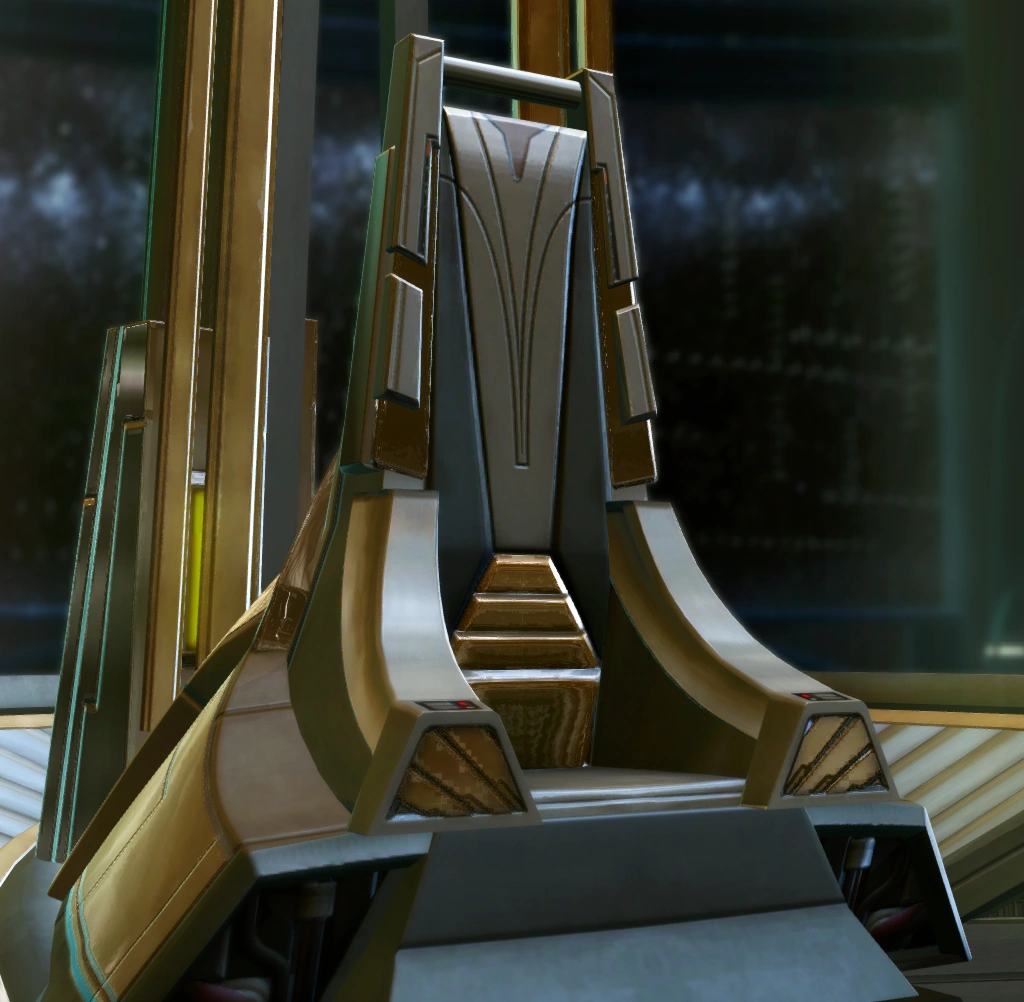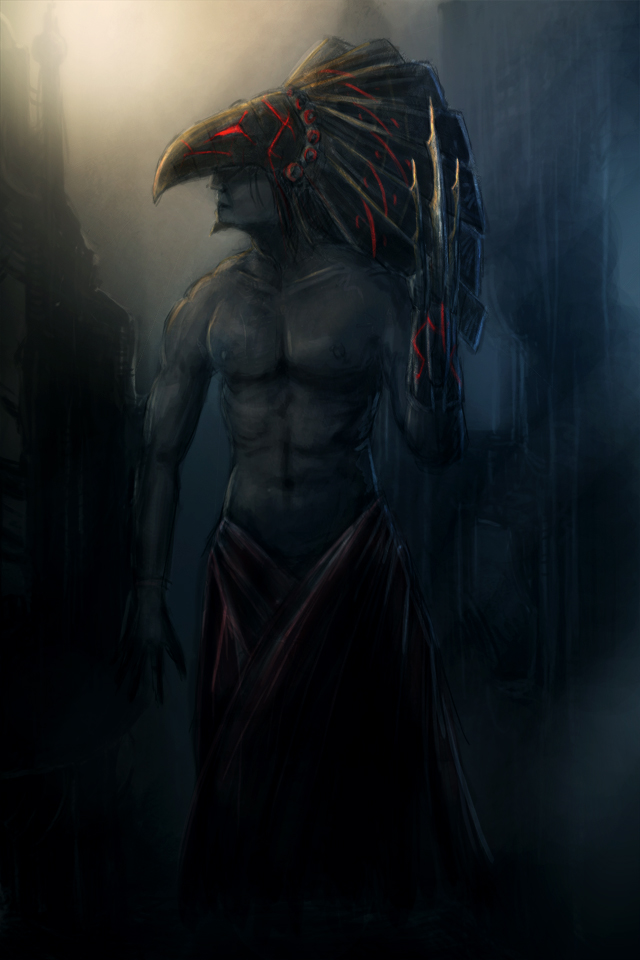The Ranathim Tyranny
~3000 to 2500 BD The Reign First Tyranny (The Galaxy)(~2060 to 1550 BDC Lithian; ~70 to 85gc U Eldothic)
At the end of the
Monolith War, the Ranathim Tyranny found itself in control of a
powerful military, including secret access to the Deep Engine, war
machines crafted of synthetic flesh and raging berserkers empowered
by Dark Communion and the first psi-swords. The rest of the Galaxy
hailed the Ranathim as heroes, and while they hated the bizarre
experiments and otherworldliness of their Eldothic overlords, much of
the Galaxy had come to depend on the trade routes created by the
Eldothic Empire, which the Ranathim Tyranny essentially inherited.
Thus began the rule of the first Galactic Tyranny. As with the
Eldothic Empire, this was limited to the Arkhaian Spiral, the Umbral
Rim, and the Galactic Core.
- The Refugee Crisis: The
Ranathim allowed scattered populations to return to their
homeworlds, which made them very popular with races like the Keleni,
but caused friction with races that had taken up those new areas.
The great movement of peoples across the galaxy created a great deal
of tension.
- Ranathim Decadence: The
Ranathim perched atop a galaxy-spanning empire, and no longer had to
fight a war to access spoils. Slowly, the tough leadership of the
Tyranny began to soften into decadence and corruption and officials
used their position to access the most succulent of slaves or to
line their pockets or gain false prestige by conquering some minor
alien race.
- Proliferation of Cults:
The
tension of the various cults within the Tyranny never really
resolved during the existential crisis of the Monolith War, and
those tensions grew greater as a pan-galactic exchange of ideas led
to more and more cults, all with conflicting perspectives on similar
ideas.
- Eldothic Vengeance: The
Eldothic Empire may have been destroyed, bu the Eldoth themselves
proved extremely difficult to kill, thanks to their regeneration
sarcophagi and the hidden power of their Deep
Engine. Eldothic agents began to spread poisoned secrets, foment
rebellion and draw in the corrupt and decadent with promises of
occult power. They then turned these agents against the Tyranny,
assassinating major officials and spreading disinformation and
chaos.
- The Rise of the
Inquisition: The
Tyrant, frustrated by heretical cults, Eldothic saboteurs and mass
population movements, began to crack down on his own Empire. Once
hailed as heroes, the Ranathim now deployed the very oppression that
the Eldoth had represented.
- Revolution: The
inquisition did little to slow the crack-up of the Tyranny, and
revolts began to spread as isolated alien populations or trade
networks sought independence from the leash of Ranathim slavery.
(~2060 to 1650 BDC Lithian; ~85 to 98gc U Eldothic)
Eldothic
Sabotage, revolts, internal dissension, palace coups and religious
wars finally tore the Tyranny apart. A Rump state remained in the
Umbral Rim, and it ostensibly still ruled over the entire extent of
the Empire, with many warlords “ruling in its name,” but in
practice, the Tyranny no longer had the military might to express its
power and will. It became a largely ceremonial and religious
institution while Trader Caravans, Gaunt remnants, Ranathim pirate
lords, Keleni tribal kings and insurgent cults divided the empire
among them. Still, the idea of
the Mystical Tyrant remained a potent force.
(1147 BDC to 1 DC Lithian; 98 to 132gc U Eldothic)
A new Mystical
Tyrant dynasty arose, almost certainly under the leadership of
Ozamanthim (whether this was Ozamanthim the First or Ozamanthim the
Second is a point of historical contention). Under his leadership,
the Cult of the Mystical Tyrant took true shape as a force of cynical
imperial power. He created the Divine Masks system as a way of
soothing internal tension and creating tighter bonds of empire. He
used force to regain his empire, but he cemented the Tyranny with
social and religious bonds that allowed everyone within the Tyranny
to interact. Even so, he was never able to truly regain all of the
Ranathim former holdings in the Arkhaian Spiral or in the Galactic
Core closest to the Glorian and Sylvan rims.
- The Spread of the Divine
Masks: The
idea of all cults
unified
spread like wildfire through the empire. For older cults, nothing
changed, but younger cults sprang up on the nexus between cults.
“Navare” healers began to spring up as ecumenical religious
practices that allowed numerous lesser aliens to find a place for
their own traditions and taboos. “Zathare” sorcerors
began to look at the cults across the Tyranny as a source for occult
truths, including the forbidden secrets of the Eldoth.
- New Alien Powers: The
interregnum had given new alien races a chance to spread and gain
influence. This era sees the first mention of the Asrathi as
gladiatorial slaves and pleasure slaves, and the Slavers as sport
(hunted by Ranathim lords), gladiatorial slaves and, eventually,
accountants and courtly advisors. This era also sees the first
official
contact
between the Tyranny and the Mug when
the Draco Cluster leaves eclipse in 2021 BDC. This results in an
early war between the Tryanny and the Mug which the Tyranny won, and
the Mug thereafter engaged in trade, especially for slaves and
technology.
- Eldothic Experimentation
and the Awakening of the Adversary: Despite
the dire warnings of Domen
Khemet,
the Ranathim Death-Cult who protected the Ranathim from the “Dead
Gods” left over from the Eldothic depredations of the Galaxy,
“Zathare” sorcerers experimented with Eldothic secrets in an
effort to rekindle the wonders of the first tyranny. In so doing,
they may have unlocked some of the safeguards placed over
Adverserial or Corrupt powers, or may have played into the hands of
a few immortal Eldothic agents. In any case, many of these
expeditions end in silence, with their participants never heard from
again.
(1 DC Lithian; 132gc U Eldothic)
Something causes the home-star of the Ranathim to go super-nova. In so doing, it creates a black-hole around which the shattered remnant of the Ranathim homeworld circles, now called “Styx.” The death of Styx triggers a cataclysm of hyperspatial storms and reshapes the hyperspatial routes of the Umbral Rim, and spreads a great nebula across the rim called the Umbral Veil, giving the arm its name.
-1000 BD to 500 BD The Splintering and the Third Tyranny (The Umbral Rim)
(1 DC to 500 DC Lithian; 132 to 148gc U Eldoth)
The Dark Cataclysm
severs the Tyranny’s ability to control the full extent of its
territory, and it promptly collapses practically overnight. The Mug
manage to plunder numerous worlds of the Umbral Rim, forcing client
races like the Slaver to isolate and protect themselves. The Traders
form new trade ties in the Galactic Core, and the Ranathim Tyranny
splinters into several fragments, as none can rule from the
homeworld: one centers on Chronos in the Galactic Core (heavily
Trader influenced), one from Rath in the Sanguine Stars (heavily
Slaver influenced) and one from Sarai in the Corvus constellation
(beset by the Mug (who invaded between 27 DC and 227 DC), and
considered by historians to be the primary “legitimate” successor
state).
None of these
survive longer than 300 years before various succession crises or
rising warlords force these too into collapse. The galactic core
churns with instability until all vestiges of Ranathim power have
faded, leaving only pirates, aliens and, especially, Traders.
Ranathim power lasts a little longer in the Umbral Rim before it too
splinters.
This era is
concurrent with the spread of humanity, and the records of the first
human slaves show up in Ranathim court records, all of Westerly
stock.









